
High wintertime interior humidity issues are rarely discussed with respect to today’s “tightly” constructed homes. Most Internet search results concerning this topic return articles about the “ideal” humidity level for household interiors in winter. I’d like to offer some insight I acquired from practical experience with hope that these details can help others from having to prematurely remodel their new homes. The application of information learned during the design phase can definitely help avoid problems down the line.
Conditions and construction
This story begins in 2018 with the research and design of a small, energy-efficient house in the City of Ashland, Oregon, which is just north of the California border along Interstate 5. Ashland’s climate can be described as a mix between Western Oregon’s marine temperate and California’s Mediterranean, with an occasional twist of alpine harshness. Although the average temperatures are temperate, the record lows and highs for each month indicate that such temperature extremes do occur. The ASHRAE annual dry bulb temperatures are 18° F (-7.7° C) low and 104° F (40.1 °C) high.
During the first winter occupying the house we noticed condensation forming on the bottoms of most windows, especially in the mornings. Condensation build-up was beginning to ruin the brand-new Douglas fir window frames, and so began our humidity investigation and remodeling odyssey.
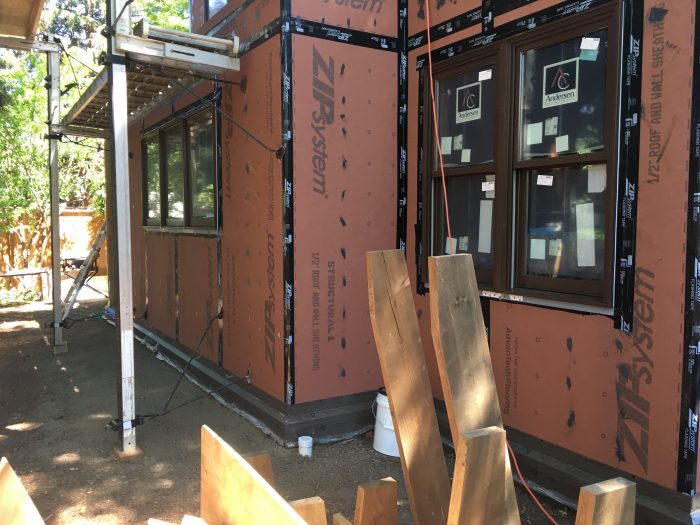
Our one-bedroom house is roughly 900 sq. ft; it is deemed an accessory dwelling unit (ADU) by Oregon permitting officials. It was constructed with Zip System sheathing as the weather-resistant barrier (WRB); and envelope penetrations were kept to a minimum. The 2×6 walls are insulated with R-23 Rockwool batts, and the ceiling insulation consists of R-31.5 (9-1/2 in. of loose-fill cellulose) in the I-joist cavity, with an additional R-15 (3 in. of XPS rigid foam) applied above the roof sheathing. Total ceiling insulation is R-46.5.
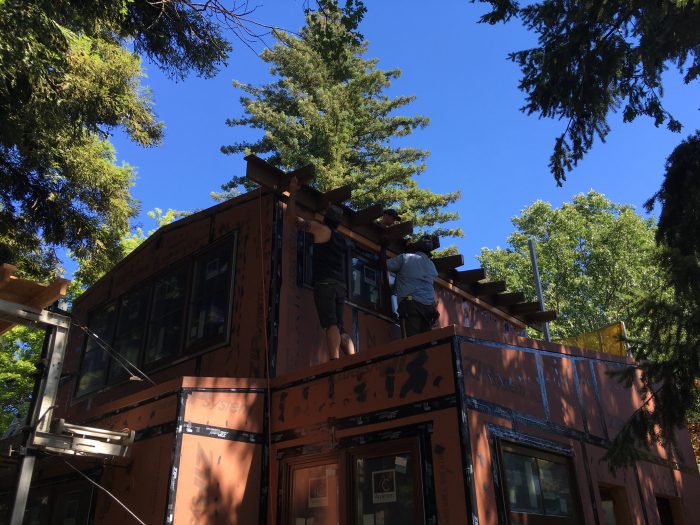
We used false rafter tails for all roof overhangs. These were constructed as modules, which were installed after the Zip panels had been applied and taped. Our decision to go this route was based on the idea that energy efficiency is enhanced with applied overhangs because they help to avoid gaps in the WRB, which typically occur where the rafters cross the top plates.
Windows and ventilation
The window package consists of double-pane, low-E glass with a U-factor of .27. The interior window frame material is Douglas fir and the exteriors are fiberglass. For fresh air, our house design includes the Lunos e² fan system for heat recovery ventilation (HRV). This is a simple, highly-efficient ductless system. It operates with two fans installed directly in the exterior wall. The regenerative ceramic core is charged every 60 seconds, after which the fan reverses and the incoming air absorbs the stored heat on its way in.
After learning that our windows were not faulty, one of my first questions was: Where is this excess humidity coming from?
I came up with a list of possible sources:
- The curing polished-concrete floor; this takes time—at about 1 in. per month of concrete slab thickness. (Not much to do but wait it out.)
- Unvented pilot lights on a 1948 Wedgewood stove (Turn off as many as you can.)
- Cooking (Always use the kitchen exhaust fan.)
- Showering (Always use the bathroom exhaust fan.)
- Rack-drying clothes indoors; great way to save energy and prolong the life of your clothes.
- Breathing; two humans, one cat
- Plants; a few orchids
- Big air leaks; none were identified in the new house
- Lack of vapor barrier beneath slab; this was definitely installed
During the design phase we read articles from Green Building Advisor and the Journal of Light Construction about energy-efficient building practices. We followed the local building code and hired an excellent general contractor. The topic of wintertime humidity never came up in relation to building a “tight” house. The humidity is there; it forms condensation on the windows in the morning, after the coldest part of the night, because the internal relative humidity of the house is too high and the outside winter temperatures are too low. (You can’t beat back the laws of physics.) It’s typically worst around the frame edges. And here’s the rub: If the window is cold enough, it doesn’t have to be that warm or that moist indoors for this to happen.
Finding the fix
Maybe the issue is related to the house being small, or the fact that the interior frames are wood, or that we used double-pane glass, or that the Zip System sheathing has a permeability to the outside of 12 – 16 perms. These factors make for a very tight and energy-efficient building envelope/air barrier, which of course can’t be changed.
Solutions pointed toward reducing and removing the excess humidity as efficiently as possible. We purchased a hygrometer to measure interior humidity but found that even when we eliminated the leading moisture culprit, air-drying our laundry, the condensation issues persisted.

We concluded that installing a desiccant-wheel dehumidifier would be the best answer to our condensation woes. These relatively small units create water vapor as opposed to liquid water output. They work by installing a 1-1/2-in. moisture vapor duct pipe from the dehumidifier unit to the outside. It is true that dehumidification takes energy, but the amount is small compared to running a clothes dryer, which is essentially a quick, high-powered dehumidifier when properly vented outside.
Sheetrock removal and repair was necessary to snake the duct pipe through the ceiling and out the exterior wall. I mention this because it sure would have been nice to avoid cutting into freshly painted sheetrock. Also, we had to make the appropriate connections into the HVAC ductwork. (We installed the Ecor Pro 50 pint dehumidifier unit upside down on the ceiling of our pantry.)
Key takeaways
Many parts of the U.S. have winter nighttime temperatures below 30 degrees. This seems to be the threshold when condensation begins to form with interior humidity in the 40% range. This level of relative humidity is difficult to maintain in a tightly constructed house. Without dehumidification, our small, energy-efficient design couldn’t dissipate the moisture we were creating.
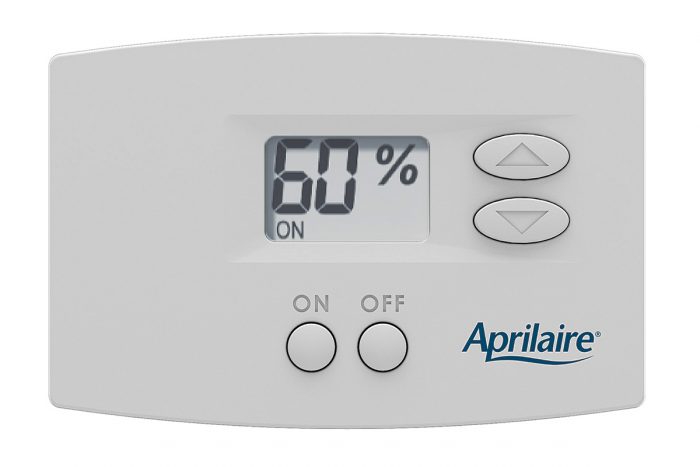
Another note of importance is dehumidification control, which can be accomplished with a wall-mounted device called a humidistat. By incorporating an outdoor sensor to measure the exterior temperature and adjusting the control for every 0.5°F fluctuation, a smart humidistat can increase the setpoint during warmer weather to achieve greater comfort and decrease the setpoint during colder weather to avoid window condensation. Controlling interior humidity—depending on exterior temperature—saves energy since outdoor temperatures usually rise during the day, when not as much dehumidification is needed.
In short, the colder it gets outside, the lower the interior relative humidity percentage needs to be to alleviate condensation, as evidenced in Table 1:

Installing a small dehumidifier has alleviated our winter window condensation problems. If your project involves designing with an airtight envelope in colder climates, it makes sense to include dehumidification in the architectural planning to eliminate the possibility of window condensation. This upfront cost for equipment and installation is likely less than dealing with a costly remodel down the road.
________________________________________________________________________
David Garden is a professor at Southern Oregon University and Pasadena City College where he teaches cinematography and film production. He builds furniture and has loved construction ever since his undergraduate work as a civil engineer at Northwestern University. Photos courtesy of author, except where noted.
Weekly Newsletter
Get building science and energy efficiency advice, plus special offers, in your inbox.






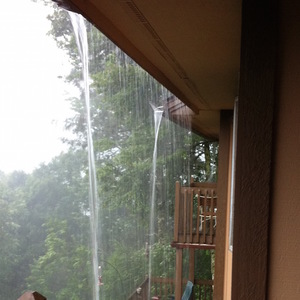
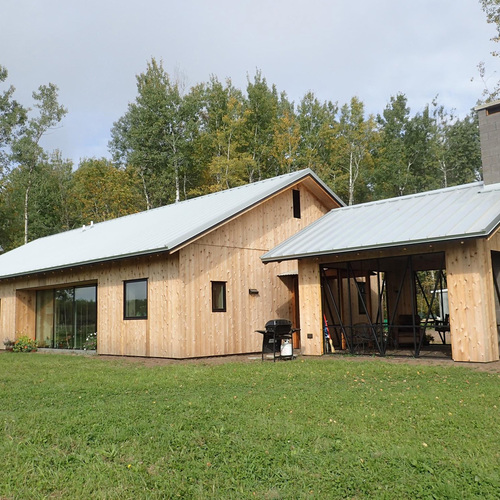
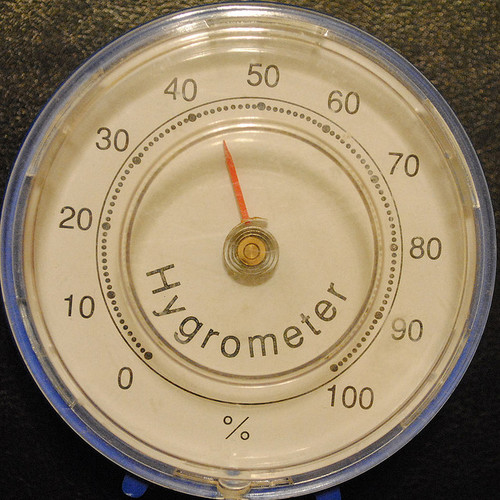






24 Comments
Window condensation is one of the questions I ask in both energy audits and building investigations and a discussion I have with homeowners and contractors I consult with for new construction. A few additional questions I would have asked you are:
What was your blower door score? (If you were in my market, a blower door test would have been required in all new homes built after 2015. Leakier houses usually have less of an issue with high wintertime humidity.)
Are you lowering window coverings during the overnight? (This often results in a lower glass temperature resulting in condensation forming. It clears quickly if the blinds are raised right away in the morning.)
Are you monitoring humidity levels? (25-30% is where I recommend wintertime humidity levels for my climate if the home is built using standard double pane windows. I've been pushing for triple pane windows in new construction for a few years, mostly because a slightly higher indoor humidity level can be maintained. Very few homeowners and contractors take that advise.)
Being in climate zone 7, I see a lot of homes with window condensation, as a matter of fact, at -20°F, most homes in my area will have a little condensation and sometimes ice at the very bottom of the glass. We've been code required to install balance mechanical ventilation in all new construction since the early 2000's, usually HRV's are installed, this has helped to control humidity levels (and improve indoor air quality) during the heating season, that is as long as the homeowner has been trained on how to operate and maintain the unit and actually use the system.
One last question, where did you source the table showing the recommended interior wintertime humidity levels?
"...at -20°F, most homes in my area will have a little condensation and sometimes ice at the very bottom of the glass."
At -20, unless the indoor air is "nose-bleed" dry, I would anticipate more than a little condensation (and in many cases frost or ice) on most dual pane windows. I agree 100% that anyone in zone 6 or above needs to install triple pane windows if they want to avoid winter-time window condensation.
Randy,
Thanks for your excellent comments on the article.
Answers to your questions:
1) We did not get a blower door score since the City of Ahsland, Oregon did not require it to get our certificate of occupancy. We discussed this with our contractor but decided against paying to have it done by an outside firm. In the time since, I learned that the City has an energy auditor who has his own blower door test equipment. I need to make an appointment with him to arrange a test. He said it would be free. I will let you know the score.
2) We do not have any window coverings
3) Yes, we monitor humidity levels. We have found that with the newly installed Ecor Pro dehumidifer we can keep condensation from building up if we use the wintertime exterior temperature versus interior humidity levels chart and keep the humidity level below the set point. It works like a charm.
4) In retrospect, triple pane windows would have been a smart idea in our climate considering that we built a "tight" house. We just didn't know that this would be an issue. This is one of the reasons why I wanted to write the article. If you research "Passive House" and wintertime humidity problems. You will see that winter window condensation can be problematic. We didn't know that we needed to include the search terms, "Passive House." This is general problem with searching on the internet if you don't know the proper terms that you need, you may not get important results.
5) The wintertime exterior temperature versus interior humidity levels chart is used at the AprilAire website as well as on other web pages. Here is a link:
https://www.aprilaire.com/benefits/preservation/relative-humidity-chart
6) One final note is that there appears to be only one humidistat on the market, which takes the exterior temperature into consideration for dehumidification. This is an important step, which can help save energy as it will vary the interior humidity depending on outside temperature just like the above chart. It is the Viconics VH7200A1000 Humidistat. These can be kind of pricey and have some lead time for manufacturing. I will be purchasing one of these units before next winter. I recommend shopping around for this item.
Building Equinox has an excellent set of articles on humidity control. They have the CERV2 interconnected with a dehumidifier.
Your list of sources of indoor moisture caused a bit of a cringe (and nostalgic smile) when seeing rack drying laundry inside your home on the list. Reading it brought back memories of my mother (and our neighbors) hanging wet laundry in the basement during the winter months (zone 6, MN), or for smaller items (socks and such) often laying or hanging them on or above the cast iron steam radiator.
Oberon,
We are true believers for air drying our clothes. We have a dryer and use if for towels and sheets. Air drying is very energy efficient and helps to keep plastic fibers out of the environment. Plus, your clothes last much longer. A photo of our English, PulleyMaid rack is below. It can be lifter to the ceiling on two ropes.
As long as you can control the moisture level in your home, there are a lot of plusses to air drying, but that is a pretty significant amount of water to deal with, as you pointed out in your article.
That's a very nice drying rack, a lot different than clothesline and flimsy wood-dowel racks that I remember.
Thanks for writing this article, I think controlling humidity in well-built houses is under-emphasized and not necessarily straightforward, as the use of a smart humidistat shows.
Aside: that is a lovely house.
Andrew,
From my internet research, the only truly "Smart" humidistat, which takes exterior temperature into consideration for winter dehumidification is this unit, Viconics VH7200A1000 Humidistat. These can be kind of pricey and have some lead time for manufacturing. I will be purchasing one of these units before next winter. I recommend shopping around for this item.
I don't know if our experience is useful in this discussion or not. But our well insulated, tight (.59ach50) house with triple pane windows has never had any condensation on windows or anywhere else. We're in Maine.
Stephen,
Great point, in retrospect, triple pane glass is an excellent solution to this problem. We just didn't know that with a "tight" house this would be an issue in our Southern Oregon climate. We can only blame ourselves since we were the designers / architects and oversaw the construction. I mentioned above that we did our research but wintertime humidity problems in "tight" houses doesn't come up on internet searches unless you add the search terms, "Passive House." This is one of the reasons why I wanted to write this article and spread the awareness that condensation can be the result.
"In short, the colder it gets outside, the lower the interior relative humidity percentage needs to be to alleviate condensation"
Yes and no. The indoor air still has to come into contact with a surface cold enough to cause the moisture in that air to condense. No cold surface, no condensation.
What was your indoor humidity before and after the dehumidifier.
Do you think a more conventional heat recovery ventilator HRV moving more air could have controlled your humidity?
The desiccant dehumidifier is another unconventional choice. With a refringent dehumidifier you can measure the water output and know it is working. Is there an easy way to check a desiccant dehumidifier performance?
Walta
Walta,
Our humidity levels could spike above 60% before the dehumidifier installation. This level will definitely cause wintertime window condensation. After we installed the Ecor Pro dehumidifier we can keep the indoor humidity level down to the amount needed to keep condensation from forming. This depends on the outside temperature corresponding to the chart above. Last winter, I was adjusting this by hand. Next winter, I plan on installing the Viconics VH7200A1000 Humidistat and let it handle the adjustment with its attached outdoor temperature probe. It takes the offset into consideration and will vary the interior humidity as the outside temperature rises during the day. Then it will decrease the humidity as the nighttime temperature goes down.
Yes, I think that a more conventional and larger heat recovery ventilator HRV would help but in our design we sized the Lunos fans to the fresh air code requirements. One note about this is that you might loose some percentage of heat with a larger HRV system or two sets of Lunos fans. This would require more warming energy to compensate so I am not sure that it would make sense.
We can definitely tell that the desiccant dehumidifier is working as it quickly brings down the humidity level in just a matter of thirty minutes to an hour. It really doesn't run very much, maybe a few hours each day. You can also go outside and see a bit of steam emerging from the 1 1/2" exhaust pipe / vent. One caveat is that it is kind of noisy but quieter than a standard refrigerant dehumidifier I think.
So if we need to keep the dehumidifier running in winter just to prevent condensation on a double pane window, it would be good to account for this energy penalty (which I guess it is not negligible) when we compare double vs triple pane windows. Does this make sense to you? Would this make a significant difference on ROI? Thanks!
I don't know what the numbers say, but if a dehumidifier is running in the winter, the heat/energy 'wasted' goes into heating your house, so it's not completely wasted.
I haven't priced triple pane windows in a while, but they sure seemed pricey last time I looked. I'd probably only use them if I had a sound issue to control (e.g., noisy lot near rough road, bar, or certain types of farm animals ;) ).
Recently, I did some triple pane versus double pane costing and saw that it looks to increase your window package by 10% to 15%. In our small house with the Anderson "E" series window package at about $20,000 (2019 pricing) this would have increased the price by about $2,000 to $3,000. It seemed to be about 20 years to pay back the extra energy of about $10 per month that the dehumidifier uses. The cost to install the Ecor Pro myself was $1000, I found the unit on eBay for about $800. My calculations are rough, our power in Ashland is about 19 cents per kilowatt hour.
Also, Andrew mentions that running a dehumidifier in winter adds energy to your house. This is true for a standard refrigerant dehumidifier. In our case, the desiccant wheel type dehumidifier doesn't really heat the house very much since most of the heat it creates is used to dry the wheel and is pumped outside through the 1 1/2" vent pipe.
One additional note is that your triple pane windows will make your house more energy efficient for heating and cooling, which will save additional costs. I am not sure if I know how to calculate this amount. Maybe someone else has this information and could comment about it.
Thanks so much for your article and the resulting discussion. We too have a tight, small house with double pane windows. Like you we monitor indoor humidity and have condensation on the inside of the windows on cold nights, with resulting black mold on the bottom of the window sills despite keeping humidity below 50% at all times.
This issue needs a lot more attention than its been getting. We are seeing very tight houses with triple glaze windows and there is no condensation on the interior of the windows. So.... double pane windows transfer to much cold air to the interior window pane resulting in condensation of the warm interior air. I wish we had known!!!
Valli Genevieve
Great discussion, and important to remember not all triple glazed windows are created equal. Many manufacturers use triple glazed insulated glass units with the air spaces minimized to maintain an overall glass thickness that fits in the sash. The NFRC tests for something called "condensation resistance" and if the manufacturer doesn't advertise the data ask them for it. Many of these "skinny" triples don't offer much improvement over a basic 2x glazed unit. For reference, a traditional double glazed unit with argon scores in the high 40s to low 50s. If you use a triple glazed window with a 2-1/4" sash it will often carry a triple IGU with two half-inch airspaces and offer CR ratings in the 60s. The design, construction and composition of the glazing system makes all the difference.
I'm a firm believer in making the extra investment for triple glazing. It still works when the power is out and doesn't require maintenance. With codes ratcheting down it is indeed becoming the cost of doing business in northern climates. The interior surface coatings that are used only lower the CR rating yet that's not addressed by E-Star. The mid-Atlantic is going to require a .25 u-value and I suspect many folks will meet that with I89 and other interior coatings. The lower CR rating should prove to be interesting when folks in climate zones that never saw condensation begin to in the coming years...
All the talk about internal humidity, external air temps and RH makes it seem like window condensation is a foregone conclusion if circumstances dictate. But don't most people (maybe its just Canadians) feel that A) regardless of air tightness, a window that acts as a hole in the thermal envelope is going to condense moisture, so if the R-values (1/u) of your windows (and frames) are similar to your walls (IE quality triple-glazed units), they will be no more likely to attract condensation than any other surface.; and B) if the internal surface of your glazing is exposed to warm air currents (that's why heating vents are located under windows) the surface will stay warm enough to avoid condensation. However, i do understand that condensation is far more prevalent in moisture rich coastal climates, than in dry central Canadian winters.
Good point, but also in densely populated areas folks like to use curtains which renders the heating vent useless until the next morning in most cases. We need little mini solar powered fans that blow just enough air at night on the glass behind the curtain...
I do not expect windows to condense moisture, if properly specified and if interior humidity is controlled. That's why the condensation resistance testing exists.
The highest-performing windows are about R-11, which is a pretty terrible wall. If you're using R-11 windows, your walls are likely R-20 to R-40 or even higher. Code-compliant windows in cold climates are about R-3. I hope you aren't building R-3 walls.
In drafty old houses, heat registers were located under windows when possible partly to reduce condensation, and largely because crappy windows lose a lot of heat and feel drafty. In higher-performing new homes, there is likely only a single heat supply in each room, and in many cases it's located on a wall or ceiling, not the floor.
“[Deleted]”
David,
Great article. I’m a bit further up I5 from you in CZ4 and notice a lot of folks who lack the appreciation for the entire sorption process you get here when it’s cool, but the dew point is a couple of degrees below the air temperature for hours at a time. I also like your vapor open envelope design, as I’m trying for the same or even higher permeability for best drying potential on a remodel of a 120 year old house.
I will be curious to see what your blower door test comes in at if you are able to get one. One of the side effects of the desiccant dehumidifier is that it causes negative air pressure. Are you bringing in any makeup air for it? I’m torn on getting one of these myself because of this. Regular, compressor based dehumidifiers have horrible efficiency when operating in the 70 degree range or less, which would be my case too.
Log in or create an account to post a comment.
Sign up Log in